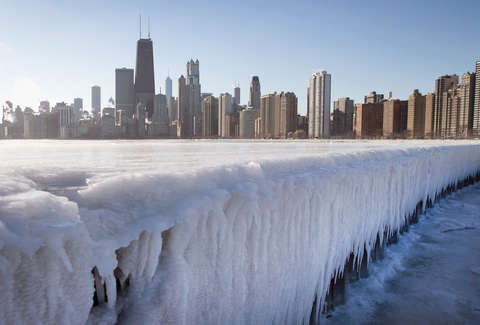Arctic Blast Surges the Midwest and Northeast

March 1, 2019
Storms raging the Midwest, often referred to as the “polar vortex,” have created some of the lowest temperatures in history, calling for a state of emergency in some regions. The cause of these storms is widely debated— the most popular theory being climate change.
Climate change is defined as drastic changes in temperatures caused by too much carbon dioxide in the atmosphere. Observations have shown that this change in climate is responsible for the rapid rate of melting icebergs in the Arctic. When this occurs, the cold air above the Arctic, referred to as the polar vortex, becomes weaker. As the polar vortex weakens, it is susceptible to movements and shifts. The warming of the Arctic additionally produces negative effects on the jet stream, which leads to colder temperatures in the Northeast. The jet stream is composed of strong and fast winds that reach speeds upwards of 275 miles per hour around the Arctic. Much like with the polar vortex, global warming forces jet stream winds to be pushed further south. As climate change moves the cold air of the north southward, the warm air around the equator also moves north, and the jet stream is pushed into a zig-zag pattern that reaches into North America. This rush of cold has wreaked devastating effects across the Northeast and Midwest portion of the United States.
Upwards of 600 temperature records have supposedly been broken or tied during the winter storm surge, which has led to many governors to declare a state of emergency. In Cotton, Minnesota, temperatures sank as low as -56 degrees Fahrenheit. The lowest recorded temperature for the state is -60 degrees, just four degrees lower than the temperatures induced by the storm. In Chicago, the daily temperature average was as low as -17 degrees. This is just one degree higher than the record daily average set in December of 1983.
These record-lows have proven fatal, especially in the case of a University of Iowa student, Gerard Belz. Belz was found by campus police behind a building on Iowa’s campus, in which he later died at a nearby hospital The temperature when the student was found was around -20 degrees Fahrenheit, with a wind-chill recorded as a shocking fifty degrees below zero. This extreme cold resulted in an abundance of shutdowns and related deaths across the Midwest.
The record temperatures resulting from the polar vortex created some of the coldest temperatures in North American history. Not all records have been broken, but the temperatures have reached such extremes that many scientists are investigating the causes of these storms. Though this Winter proved harsh for many Americans, hopefully, this Arctic blast will prompt further studies to better determine the causes of these storms and predict them in the future.





![al.com. (2023). People attended a prayer event... [Photograph]. https://www.al.com/news/2023/11/after-mayor-bubba-copelands-death-community-gathers-to-pray-smiths-station-is-hurting.html](https://theacademyadvocate.com/wp-content/uploads/2024/02/KON5NNEUI5GVNO5AG4R4G25JRQ.jpg)







